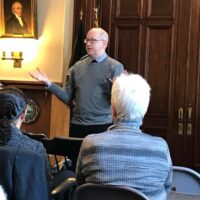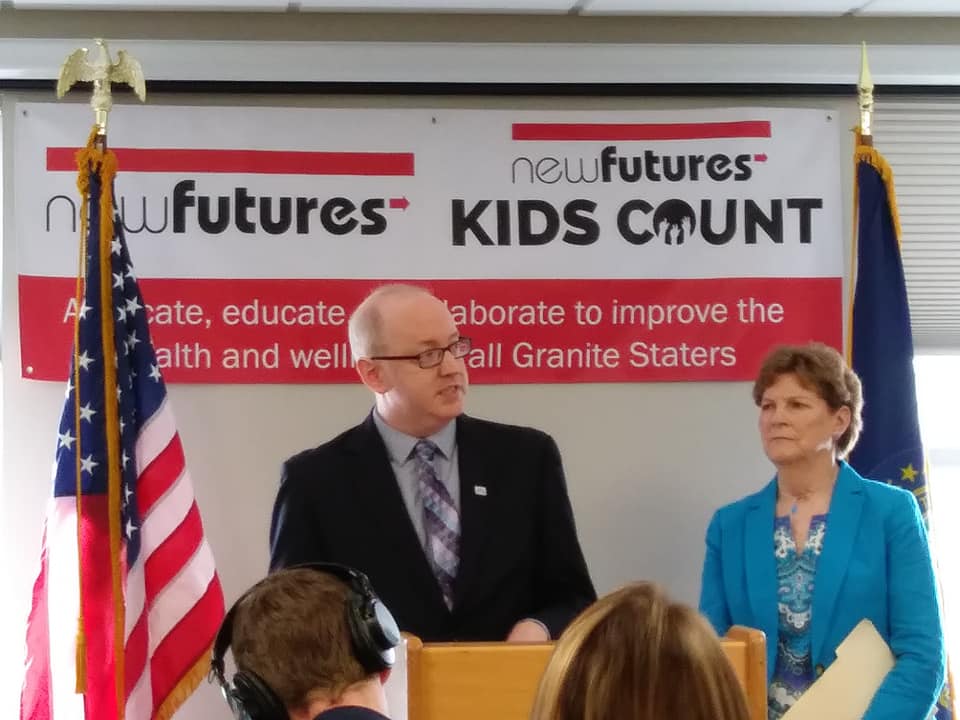Tym Rourke at Kids Count Event with U.S. Senator Jeanne Shaheen
Tym Rourke has been engaged in prevention efforts for almost his entire life. As a high school student, he joined Students Against Destructive Decisions (SADD) and later served as the president. After receiving his master’s degree in intermodal expressive art therapy, Tym started his career as a clinician at an alternative school for kids with behavioral health issues before shifting his focus back to youth substance use prevention work. In 2008, he transitioned to behavioral health philanthropy, serving as a director for the New Hampshire Charitable Foundation, overseeing their Substance Use Disorders Portfolio – a position he held for 13 years while concurrently chairing the New Hampshire Governor’s Commission on Substance Use for eight years.
Prevention and Philanthropy
For as long as Tym can remember, he has cared deeply about substance use issues, particularly as they relate to kids. He credits his involvement with SADD, New Hampshire Teen Institute and other youth leadership programs as launching his career in youth substance abuse prevention. Being a clinician gave him an opportunity to bring his passion for the arts into the work he was doing on behavioral health issues, but came to realize he wanted to make an impact upstream through a focus on prevention. “So many diseases, including behavior, are preventable,” Tym said. “There are ways in which you can build up systems to not only support treatment and recovery but also reduce the pipeline of people who would need more and more clinical services by giving people what they need when they need it.”
Throughout Tym’s career, he has had multiple opportunities to build those systems in his home state of New Hampshire and across the country. As a director at the New Hampshire Charitable Foundation (NHCF), he provided coaching and mentoring to numerous nonprofits in areas such as early childhood education and care, family and youth support, and substance use disorders services. His work with NHCF not only afforded him an opportunity to apply his expertise in behavioral health and prevention issues but also gather a lot of experience and insight into the life cycle of a nonprofit, and how to build, support, and sustain vibrant mission-driven organizations.
He also chaired the New Hampshire Governor’s Commission on Substance Use (Governor’s Commission), an opportunity Tym describes as “the honor of a lifetime.” At the time Tym accepted the assignment, New Hampshire had the highest rates of substance use disorders, was 49th in treatment access and per capita expenditure, and had the highest rates of youth alcohol consumption. Yet, the state did not have a strategy to tackle the issue. “I recognized I was in a really unique position to reactivate and re-energize that commission, and I wanted to make it a tool to serve the community, state agencies, and legislature.”

Tym speaking at NH State House
He started by asking every state agency commissioner or head how the Governor’s Commission could help them address substance use. He also invited agency heads and commissioners to talk about what their respective departments were seeing. Giving agency heads an opportunity to speak helped the state create its strategic plan to address opioids, develop a prescription drug monitoring program, implement pain management classes in the Department of Corrections facilities, and expand services for pregnant and newly parenting women. The Governor’s Commission and community stakeholders also worked with a bipartisan group of legislators to expand Medicaid, including the development of a robust substance use disorders benefit. In the years following Medicaid expansion, New Hampshire saw a six-fold increase in treatment across the state. “We were successful because the entire group of stakeholders – legislators, community advocates, providers, state agencies, the governor’s office, etc. – showed up at the table and committed to following the data, making sensible decisions, and using resources wisely,” Tym said. “It is all about how you build systems and bring the right people around the table so that everybody understands their part, and everybody can feel good about it, especially when it involves getting people to do things that they may be hesitant to do.”
Tackling Thorny Issues
As Tym’s work with the Governor’s Commission and the NHCF continued, he became increasingly aware that the way New Hampshire organizations ommunities, and state agencies were addressing substance use and addiction could be replicable elsewhere. Tym began to present on the work in New Hampshire at the national level, and worked with colleagues form other philanthropic institutions to co-found the Substance Use Disorders Funders Network, bringing together philanthropic organizations committed to strategic investments in substance use prevention, harm reduction, treatment, and recovery.

Tym and Greg Williams at 1st NH Recovery Rally
Along the way, he was introduced to Third Horizon Strategies (THS) Managing Director Greg Williams and an opportunity to join THS presented itself. “I was excited to work in a consultancy role where I could take both the lessons learned and the expertise that I have in behavioral health and other health care policy and systems building, and my understanding of the business of nonprofits to other organizations doing work I deeply believe in,” Tym said.
He continues to be inspired by the people and the diversity of issues and solutions he is exposed to every day, and partnering with diverse clients to help them accelerate their work.
Tym said that one of the thorny issues that confronts many organizations across the country is transitioning from a grassroots organization into a sustainable, strategic nonprofit business. Tym described that in the lifecycle of nonprofits, an organization usually starts with a grassroots structure that is founded by people who are “all heart” – incredibly passionate about the issue and many with lived experiences on the issue the organization is established to address. However, they often don’t bring the business acumen that goes with being a nonprofit. In the absence of developing such acumen, many well-intentioned and important organizations are challenged to accomplish their mission, and in some instances, they can fail. “Both the power of the work that I did prior and the power of the work I am doing at THS is choosing to not just work with the big organizations, but also the ones that are smaller or earlier staged, where they could use coaching and guidance to take their operations and impact to the next level,” Tym said. “The most exciting moment of an organization’s evolution is when you can help them make that transition.”
When asked if he has a mantra, Tym quoted Siouxsie Sioux, vocalist for the post-punk band Siouxsie and the Banshees, “My goal in life is to be a thorn in the side of mediocrity.” “In my career, I’ve been very blessed not to have just taken a job, but to do the work that I believe in – the work of helping people find their voice and elevate their own work in whatever way I can,” Tym said.
Champion for a Better Health Care System
While many describe the nation’s health care system as “broken”, Tym takes a more nuanced view. “It’s not that the system doesn’t work,” he says, “it’s that it works only in certain circumstances, and for certain people.” Tym’s view stems from his own personal experience, navigating the health care system as a parent of a child with highly complex medical needs. When his infant son was diagnosed with cancer, Tym saw firsthand what can happen when an integrated care team wraps itself around a patient and their

Tym with his wife, son, and daughter
caregivers, and insurers act as a partner in ensuring proper care. His son, now 17, continues to rely on a care team in managing his survivorship. Tym’s desire is for the nation’s health care system to resemble what the system looked like for him and his family when they needed it most – for everyone.
“If we want to transform the health care system, we need to address its injustices, inequities and challenges, but also recognize the people who are in it to do good on behalf of patients,” Tym said. “We need to make sure the patients can access care and that providers can get to the patients they have built their career to serve. For me, the work is not about just dismantling the whole thing; it is about elevating what works, transforming what doesn’t, and lifting the entire system up.”

